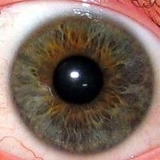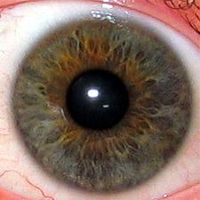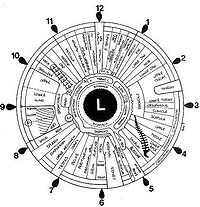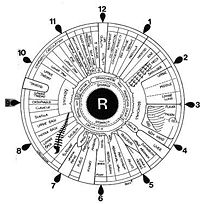
Iridology
Encyclopedia
IridologyIridology (also known as iridodiagnosis or iridiagnosis is an alternative medicine
technique whose proponents claim that patterns, colors, and other characteristics of the iris
can be examined to determine information about a patient's systemic
health. Practitioners match their observations to iris charts, which divide the iris into zones that correspond to specific parts of the human body. Iridologists see the eyes as "windows" into the body's state of health.
Iridologists use the charts to distinguish between healthy systems and organs in the body and those that are overactive, inflamed, or distressed. Iridologists believe this information demonstrates a patient's susceptibility towards certain illnesses, reflects past medical problems, or predicts later health problems.
As opposed to evidence-based medicine
, Iridology is not supported by quality research studies and is widely considered pseudoscience
.
 Iridologists generally use equipment such as a flashlight and magnifying glass, cameras or slit-lamp microscopes to examine a patient's irises for tissue
Iridologists generally use equipment such as a flashlight and magnifying glass, cameras or slit-lamp microscopes to examine a patient's irises for tissue
changes, as well as features such as specific pigment patterns and irregular stroma
l architecture. The markings and patterns are compared to an iris chart that correlates zones of the iris with parts of the body. Typical charts divide the iris into approximately 80-90 zones. For example, the zone corresponding to the kidney is in the lower part of the iris, just before 6 o'clock. There are minor variations between charts' associations between body parts and areas of the iris.
According to iridologists, details in the iris reflect changes in the tissues of the corresponding body organs. One prominent practitioner, Bernard Jensen
, described it thus: "Nerve fibers in the iris respond to changes in body tissues by manifesting a reflex physiology that corresponds to specific tissue changes and locations." This means that a bodily condition translates to a noticeable change in the appearance of the iris. For example, acute inflammatory, chronic inflammatory and catarrhal signs may indicate involvement, maintenance, or healing of corresponding distant tissues, respectively. Other features that iridologists look for are contraction rings and Klumpenzellen, which may indicate various other health conditions, as interpreted in context.

 The first use of the word Augendiagnostik ("eye diagnosis," loosely translated as iridology) began with Ignaz von Peczely
The first use of the word Augendiagnostik ("eye diagnosis," loosely translated as iridology) began with Ignaz von Peczely
, a 19th-century Hungarian physician. The most common story is that he got the idea for this diagnostic tool after seeing similar streaks in the eyes of a man he was treating for a broken leg and the eyes of an owl whose leg von Peczely had broken many years before. At the First International Iridological Congress, Ignaz von Peczely's nephew, August von Peczely, dismissed this myth as apocryphal, and maintained that such claims were irreproducible.
The German contribution in the field of natural healing is due to a minister Pastor Emanuel Felke
, who developed a form of homeopathy
for treating specific illnesses and described new iris signs in the early 1900s. However, Pastor Felke was subject to long and bitter litigation. The Felke Institute in Gerlingen, Germany was established as a leading center of iridological research and training.
Iridology became better known in the United States in the 1950s, when Bernard Jensen
, an American chiropractor, began giving classes in his own method. This is in direct relationship with P. Johannes Thiel, Eduard Lahn (who became an American under the name of Edward Lane) and J Haskell Kritzer. Jensen emphasized the importance of the body's exposure to toxins, and the use of natural foods as detoxifiers.
reject all the claims of all branches of iridology and label them as pseudoscience
or even quackery
.
Critics, including most practitioners of mainstream medicine, dismiss iridology given that published studies have indicated a lack of success for its claims. To date, clinical data
does not support correlation between illness in the body and coinciding observable changes in the iris. In controlled experiments, practitioners of iridology have performed statistically no better than chance in determining the presence of a disease or condition solely through observation of the iris.
It has been pointed out that the premise of iridology is at odds with the fact that the iris does not undergo substantial changes in an individual's life. Iris texture is a phenotypical feature that develops during gestation
and remains unchanged after birth. There is no evidence for changes in the iris pattern other than variations in pigmentation in the first year of life and variations caused by glaucoma
treatment. The stability of iris structures is the foundation of the biometric technology which uses iris recognition
for identification purposes.
In a study published in the Journal of the American Medical Association
, three iridologists incorrectly identified kidney disease in photographs of irises and often disagreed with each other. The researchers concluded: "iridology was neither selective nor specific, and the likelihood of correct detection was statistically no better than chance."
Another study was published in the British Medical Journal
which selected 39 patients who were due to have their gall bladder removed the following day, because of suspected gallstones. He also selected a group of people who did not have diseased gall bladders to act as a control. A group of 5 iridologists examined a series of slides of both groups' irises. The iridologists could not correctly identify which patients had gall bladder problems and which had healthy gall bladders. For example, one of the iridologists diagnosed 49% of the patients with gall stones as having them and 51% as not having them. Dr Knipschild concluded:, "...this study showed that iridology is not a useful diagnostic aid." Iridologists defended themselves and attacked the study's methodology.
Edzard Ernst
raised the question in 2000: "Does iridology work? [...] This search strategy resulted in 77 publications on the subject of iridology. [...] All of the uncontrolled studies and several of the unmasked experiments suggested that iridology was a valid diagnostic tool. The discussion that follows refers to the 4 controlled, masked evaluations of the diagnostic validity of iridology. [...] In conclusion, few controlled studies with masked evaluation of diagnostic validity have been published. None have found any benefit from iridology."
Alternative medicine
Alternative medicine is any healing practice, "that does not fall within the realm of conventional medicine." It is based on historical or cultural traditions, rather than on scientific evidence....
technique whose proponents claim that patterns, colors, and other characteristics of the iris
Iris (anatomy)
The iris is a thin, circular structure in the eye, responsible for controlling the diameter and size of the pupils and thus the amount of light reaching the retina. "Eye color" is the color of the iris, which can be green, blue, or brown. In some cases it can be hazel , grey, violet, or even pink...
can be examined to determine information about a patient's systemic
Systemic disease
Life-threatening disease redirects here.A systemic disease is one that affects a number of organs and tissues, or affects the body as a whole. Although most medical conditions will eventually involve multiple organs in advanced stage Life-threatening disease redirects here.A systemic disease is one...
health. Practitioners match their observations to iris charts, which divide the iris into zones that correspond to specific parts of the human body. Iridologists see the eyes as "windows" into the body's state of health.
Iridologists use the charts to distinguish between healthy systems and organs in the body and those that are overactive, inflamed, or distressed. Iridologists believe this information demonstrates a patient's susceptibility towards certain illnesses, reflects past medical problems, or predicts later health problems.
As opposed to evidence-based medicine
Evidence-based medicine
Evidence-based medicine or evidence-based practice aims to apply the best available evidence gained from the scientific method to clinical decision making. It seeks to assess the strength of evidence of the risks and benefits of treatments and diagnostic tests...
, Iridology is not supported by quality research studies and is widely considered pseudoscience
Pseudoscience
Pseudoscience is a claim, belief, or practice which is presented as scientific, but which does not adhere to a valid scientific method, lacks supporting evidence or plausibility, cannot be reliably tested, or otherwise lacks scientific status...
.
Methods

Biological tissue
Tissue is a cellular organizational level intermediate between cells and a complete organism. A tissue is an ensemble of cells, not necessarily identical, but from the same origin, that together carry out a specific function. These are called tissues because of their identical functioning...
changes, as well as features such as specific pigment patterns and irregular stroma
Stroma of iris
The stroma of the iris consists of fibers and cells.The former are made up of delicate bundles of fibrous tissue; a few fibers at the circumference of the iris have a circular direction; but the majority radiate toward the pupil, forming by their interlacement delicate meshes in which the vessels...
l architecture. The markings and patterns are compared to an iris chart that correlates zones of the iris with parts of the body. Typical charts divide the iris into approximately 80-90 zones. For example, the zone corresponding to the kidney is in the lower part of the iris, just before 6 o'clock. There are minor variations between charts' associations between body parts and areas of the iris.
According to iridologists, details in the iris reflect changes in the tissues of the corresponding body organs. One prominent practitioner, Bernard Jensen
Bernard Jensen
Bernard Jensen was a chiropractor, entrepreneur, and the author of numerous books and articles on health and healing....
, described it thus: "Nerve fibers in the iris respond to changes in body tissues by manifesting a reflex physiology that corresponds to specific tissue changes and locations." This means that a bodily condition translates to a noticeable change in the appearance of the iris. For example, acute inflammatory, chronic inflammatory and catarrhal signs may indicate involvement, maintenance, or healing of corresponding distant tissues, respectively. Other features that iridologists look for are contraction rings and Klumpenzellen, which may indicate various other health conditions, as interpreted in context.
History
The first explicit description of iridological principles such as homolaterality (without using the word iridology) are found in Chiromatica Medica, a famous work published in 1665 and reprinted in 1670 and 1691 by Philippus Meyeus (Philip Meyen von Coburg).

Ignaz von Peczely
Ignaz von Peczely was a Hungarian physician, who is credited with the invention or re-invention of the pseudoscientific theory of iridology. Von Peczely first thought of iridology when caring for an owl with a broken leg. After noticing a spot in the owl's eye he hypothesized a link between the...
, a 19th-century Hungarian physician. The most common story is that he got the idea for this diagnostic tool after seeing similar streaks in the eyes of a man he was treating for a broken leg and the eyes of an owl whose leg von Peczely had broken many years before. At the First International Iridological Congress, Ignaz von Peczely's nephew, August von Peczely, dismissed this myth as apocryphal, and maintained that such claims were irreproducible.
The German contribution in the field of natural healing is due to a minister Pastor Emanuel Felke
Emanuel Felke
The Protestant pastor Leopold Erdmann Emanuel Felke was a naturopath who developed the eponymous Felke cure, and who was active in Repelen near Moers from 1896 to 1914 and in Bad Sobernheim from 1915 to 1925...
, who developed a form of homeopathy
Homeopathy
Homeopathy is a form of alternative medicine in which practitioners claim to treat patients using highly diluted preparations that are believed to cause healthy people to exhibit symptoms that are similar to those exhibited by the patient...
for treating specific illnesses and described new iris signs in the early 1900s. However, Pastor Felke was subject to long and bitter litigation. The Felke Institute in Gerlingen, Germany was established as a leading center of iridological research and training.
Iridology became better known in the United States in the 1950s, when Bernard Jensen
Bernard Jensen
Bernard Jensen was a chiropractor, entrepreneur, and the author of numerous books and articles on health and healing....
, an American chiropractor, began giving classes in his own method. This is in direct relationship with P. Johannes Thiel, Eduard Lahn (who became an American under the name of Edward Lane) and J Haskell Kritzer. Jensen emphasized the importance of the body's exposure to toxins, and the use of natural foods as detoxifiers.
Criticism
The majority of medical doctorsPhysician
A physician is a health care provider who practices the profession of medicine, which is concerned with promoting, maintaining or restoring human health through the study, diagnosis, and treatment of disease, injury and other physical and mental impairments...
reject all the claims of all branches of iridology and label them as pseudoscience
Pseudoscience
Pseudoscience is a claim, belief, or practice which is presented as scientific, but which does not adhere to a valid scientific method, lacks supporting evidence or plausibility, cannot be reliably tested, or otherwise lacks scientific status...
or even quackery
Quackery
Quackery is a derogatory term used to describe the promotion of unproven or fraudulent medical practices. Random House Dictionary describes a "quack" as a "fraudulent or ignorant pretender to medical skill" or "a person who pretends, professionally or publicly, to have skill, knowledge, or...
.
Critics, including most practitioners of mainstream medicine, dismiss iridology given that published studies have indicated a lack of success for its claims. To date, clinical data
Scientific method
Scientific method refers to a body of techniques for investigating phenomena, acquiring new knowledge, or correcting and integrating previous knowledge. To be termed scientific, a method of inquiry must be based on gathering empirical and measurable evidence subject to specific principles of...
does not support correlation between illness in the body and coinciding observable changes in the iris. In controlled experiments, practitioners of iridology have performed statistically no better than chance in determining the presence of a disease or condition solely through observation of the iris.
It has been pointed out that the premise of iridology is at odds with the fact that the iris does not undergo substantial changes in an individual's life. Iris texture is a phenotypical feature that develops during gestation
Gestation
Gestation is the carrying of an embryo or fetus inside a female viviparous animal. Mammals during pregnancy can have one or more gestations at the same time ....
and remains unchanged after birth. There is no evidence for changes in the iris pattern other than variations in pigmentation in the first year of life and variations caused by glaucoma
Glaucoma
Glaucoma is an eye disorder in which the optic nerve suffers damage, permanently damaging vision in the affected eye and progressing to complete blindness if untreated. It is often, but not always, associated with increased pressure of the fluid in the eye...
treatment. The stability of iris structures is the foundation of the biometric technology which uses iris recognition
Iris recognition
Iris recognition is an automated method of biometric identification that uses mathematical pattern-recognition techniques on video images of the irides of an individual's eyes, whose complex random patterns are unique and can be seen from some distance....
for identification purposes.
Scientific research into iridology
Well controlled scientific evaluation of iridology has shown entirely negative results, with all rigorous double blind tests failing to find any statistical significance to its claims.In a study published in the Journal of the American Medical Association
Journal of the American Medical Association
The Journal of the American Medical Association is a weekly, peer-reviewed, medical journal, published by the American Medical Association. Beginning in July 2011, the editor in chief will be Howard C. Bauchner, vice chairman of pediatrics at Boston University’s School of Medicine, replacing ...
, three iridologists incorrectly identified kidney disease in photographs of irises and often disagreed with each other. The researchers concluded: "iridology was neither selective nor specific, and the likelihood of correct detection was statistically no better than chance."
Another study was published in the British Medical Journal
British Medical Journal
BMJ is a partially open-access peer-reviewed medical journal. Originally called the British Medical Journal, the title was officially shortened to BMJ in 1988. The journal is published by the BMJ Group, a wholly owned subsidiary of the British Medical Association...
which selected 39 patients who were due to have their gall bladder removed the following day, because of suspected gallstones. He also selected a group of people who did not have diseased gall bladders to act as a control. A group of 5 iridologists examined a series of slides of both groups' irises. The iridologists could not correctly identify which patients had gall bladder problems and which had healthy gall bladders. For example, one of the iridologists diagnosed 49% of the patients with gall stones as having them and 51% as not having them. Dr Knipschild concluded:, "...this study showed that iridology is not a useful diagnostic aid." Iridologists defended themselves and attacked the study's methodology.
Edzard Ernst
Edzard Ernst
Edzard Ernst is the first Professor of Complementary Medicine in the world, at the University of Exeter, England....
raised the question in 2000: "Does iridology work? [...] This search strategy resulted in 77 publications on the subject of iridology. [...] All of the uncontrolled studies and several of the unmasked experiments suggested that iridology was a valid diagnostic tool. The discussion that follows refers to the 4 controlled, masked evaluations of the diagnostic validity of iridology. [...] In conclusion, few controlled studies with masked evaluation of diagnostic validity have been published. None have found any benefit from iridology."
Regulation, licensure, and certification
In Canada and the United States, iridology is not regulated or licensed by any governmental agency. Numerous organizations offer certification courses.External links
- The Skeptics Dictionary
- Quackwatch
- Confessions Of A Former Iridologist
- Your-Doctor.com
- James Randi Educational Foundation
- Iridology: not useful and potentially harmful. - Edzard ErnstEdzard ErnstEdzard Ernst is the first Professor of Complementary Medicine in the world, at the University of Exeter, England....
- Archives of Ophthalmology

